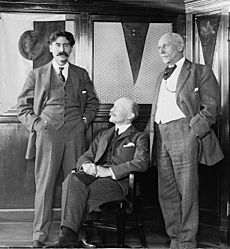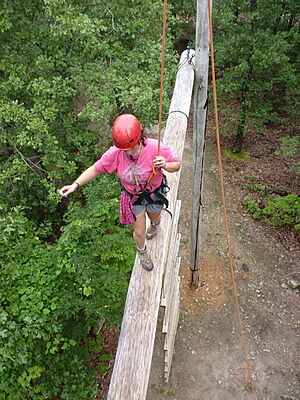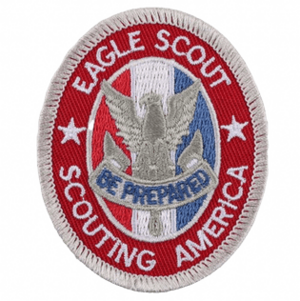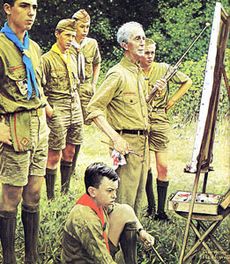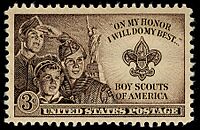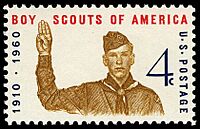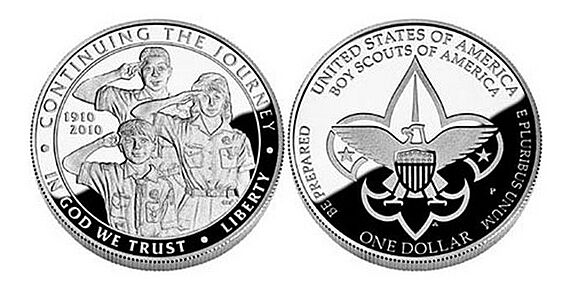Boy Scouts of America facts for kids
Quick facts for kids Scouting America |
|||
|---|---|---|---|
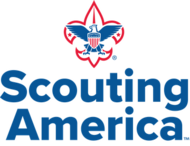 |
|||
| Previous name | Boy Scouts of America | ||
| Age range |
|
||
| Headquarters | Irving, Texas | ||
| Location | United States, Europe, Japan and South Korea | ||
| Country | United States | ||
| Founded | February 8, 1910 | ||
| Founders |
|
||
| Membership |
|
||
| Chief Scout Executive | Roger Krone | ||
| National Chair | Brad Tilden | ||
| National Commissioner | Devang Desai | ||
| Honorary Chair | President Donald Trump | ||
| Affiliation | World Organization of the Scout Movement | ||
| Governing body | National Executive Board | ||
|
|
|||
Scouting America is a very large scouting group and one of the biggest youth organizations in the United States. It has over 1 million young people, including almost 200,000 girls. The organization started as the Boy Scouts of America in 1910. Since then, about 130 million Americans have been part of its programs. It is supported by 465,000 adult volunteers. Scouting America was a founding member of the World Organization of the Scout Movement in 1922. The organization changed its name from Boy Scouts of America to Scouting America on February 8, 2025.
The main goal of Scouting America is to "prepare young people to make ethical and moral choices over their lifetimes by instilling in them the values of the Scout Oath and Law." Young people learn to be responsible citizens, build good character, and become self-reliant. They do this through many outdoor activities, educational programs, and, for older members, career-focused programs with community groups. For younger members, the Scout method teaches important Scouting values like being trustworthy, a good citizen, and outdoor skills. Activities include camping, swimming, and hiking.
Scouting America owns four special high-adventure bases for these outdoor activities: Northern Tier (in Minnesota, Manitoba, and Ontario), Philmont Scout Ranch (New Mexico), Sea Base (Florida Keys, U.S. Virgin Islands, and Bahamas), and Summit Bechtel Reserve (West Virginia). It also has nearly 100 other camps for Scouts.
The main Scouting programs are Cub Scouts for ages 5 to 11, Scouts BSA for ages 10 to 18, Venturing for ages 14 through 21, and Sea Scouts for ages 14 through 21. Scouting America works by giving permission to local groups, like churches or clubs, to run the Scouting program in their communities. Volunteers lead these groups and are supported by local councils. Learning for Life is a related program that offers in-school and career education.
In 2019, the Boy Scouts of America changed the name of its main program, Boy Scouts, to Scouts BSA. This was to show that girls could now join separate troops. Then, on February 8, 2025, the organization's 115th anniversary, the BSA officially changed its name to Scouting America. The Scout Oath, Law, and programs stayed the same.
Contents
How Scouting Began
The early 1900s were a time of change in the United States. Many families moved from farms to cities. Some people worried that young men were not learning important skills like patriotism and self-reliance anymore. Several groups tried to help with this. The YMCA worked to improve programs for young men, focusing on their mental, physical, social, and religious growth.
Other groups included the Woodcraft Indians, started by Ernest Thompson Seton in 1902, and the Sons of Daniel Boone, founded by Daniel Carter Beard in 1905. These were two important groups that came before Scouting America in the U.S.
In 1907, Robert Baden-Powell started the Scouting movement in England. He used ideas from Seton's work and other sources. In 1909, a publisher from Chicago named William D. Boyce was in London. He met a boy who helped him find his way on a foggy street. The boy refused a tip, saying he was a Boy Scout and was just doing his daily good turn. Boyce was very interested in the Boy Scouts. He met with people at the Boy Scouts Headquarters. When he returned to the U.S., Boyce was inspired and officially started the Boy Scouts of America on February 8, 1910.
Other leaders like Ernest Thompson Seton, Daniel Carter Beard, and Charles Eastman joined in. Former president Theodore Roosevelt also strongly supported the new group. In January 1911, James E. West became the first Chief Scout Executive, and Scouting grew quickly in the U.S. Groups like the Woodcraft Indians and Sons of Daniel Boone eventually joined with the BSA.
When Scouting America started in 1910, its goal was "to teach [boys] patriotism, courage, self-reliance, and kindred values." Later, in 1937, a leader named George J. Fisher said the BSA's mission was: "Each generation as it comes to maturity has no more important duty than that of teaching high ideals and proper behavior to the generation which follows." Today, the mission of Scouting America is "to prepare young people to make ethical and moral choices over their lifetimes by instilling in them the values of the Scout Oath and Law."
At its highest point, Scouting America had over 4 million young members in 1973. Today, outdoor activities are less popular, and membership has decreased. However, Scouting America is still the largest scouting organization and one of the largest youth organizations in the United States. As of 2024, it has about 1 million young participants and over 400,000 adult volunteers.
A Special Law for Scouting America
Scouting America has a special congressional charter from the U.S. government. This means Congress officially recognized the organization. President Woodrow Wilson signed this charter on June 15, 1916. One reason for getting this charter was to help Scouting America stand out from other similar groups. This special charter gives Scouting America some unique rights, like control over its symbols and badges. It shows that Scouting America is an important national organization, like the Girl Scouts and the American Red Cross.
Who Can Join Scouting?
Scouting America has four main programs:
- Cub Scouting is for children from kindergarten through fifth grade.
- Scouts BSA is the main program for young people ages 11 to 17. Ten-year-olds can join after March 1 of their fifth-grade year or if they have earned the Arrow of Light award.
- Venturing is a program for ages 14 to 20.
- Sea Scouting is for ages 14 to 20 and focuses on activities related to the sea.
There are also about 100,000 Scouts with physical or mental disabilities across the United States. They can join Scouting and stay in the program beyond the usual age limits. This helps all members grow in Scouting as much as they wish.
Other Programs and Activities
Scouting America offers other programs too:
- The Order of the Arrow is an honor society for experienced campers. It focuses on brotherhood and cheerful service. To join, members must live by the Scout Law and be chosen by their unit.
- Lone Scouting is for those who cannot easily join a regular Scout or Cub Scout group. This might be because they live in a faraway place or have special situations.
- STEM Scouts is a program that helps boys and girls learn about STEM (Science, Technology, Engineering, and Math) and prepare for careers in these fields.
- Learning for Life is a program based in schools and workplaces. It helps young people get ready for life in today's world. It builds their confidence, motivation, and self-esteem. Exploring is part of Learning for Life and focuses on career opportunities, life skills, citizenship, character, and leadership. Learning for Life programs do not use the Scout Oath, Law, uniforms, or badges of regular Scouting.
Changes in Membership
For a long time, Cub Scouting and the program then called Boy Scouting were only for boys. However, girls were allowed to join Venturing, Sea Scouting, and Explorers starting in 1970. Women could also be adult volunteers in all programs around the same time. On October 11, 2017, Scouting America announced that girls could become Cub Scouts starting in 2018. Girls could also join the Scouts BSA program starting on February 1, 2019. Girls in Cub Scouting are simply called "Cub Scouts," and members of Scouts BSA are called "Scouts."
Scouting America believes in the importance of faith. The organization states that recognizing God and being thankful for blessings helps build good citizenship. Scouting America has had Buddhist troops since 1920. It also works with the Unitarian Universalist Association, which allows for different spiritual beliefs, including humanism.
In 2000, the Supreme Court ruled that private organizations like Scouting America have the right to set their own membership rules. Over time, Scouting America has updated its policies to be more inclusive. On May 23, 2013, the National Council voted to allow youth members to join regardless of their sexual orientation. This policy started on January 1, 2014. On July 27, 2015, the National Executive Board voted to allow openly gay adult leaders and employees. Local groups can still set their own standards based on their religious beliefs.
On January 30, 2017, Scouting America announced that transgender children who identify as boys could join boys-only programs. This decision was based on the gender listed on the application, not just the birth certificate.
On May 7, 2024, the BSA announced its name change to Scouting America. This change became official on February 8, 2025, the organization's 115th anniversary. The Scout Oath, Law, and programs remain the same. Uniforms also look the same but have the new name embroidered. This change does not affect the name of the main program, "Scouts BSA," which was renamed from "Boy Scouts" in 2019.
Scouting Programs and Goals
Aims, Methods, and Ideals
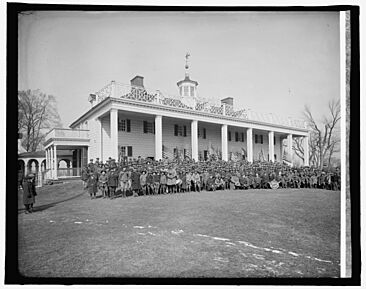
The goals of Scouting America are called the Aims and Methods of Scouting. These include Character, Citizenship, Personal Fitness, and Leadership. Scouting America helps young people achieve these goals through a learning system called the Scout method. This method is adjusted for the age of each program.
Cub Scouts wear a uniform that helps them feel like part of their group. They learn teamwork by meeting and working together in a den. They learn the Scout Oath and Law by earning ranks through completing adventures. Some activities are done at home and involve the whole family.
In the Scouts BSA program, Scouts learn to live by the Scout Oath, the Scout Law, the Outdoor Code, the Scout motto ("Be prepared"), and the Scout slogan ("Do a good turn daily"). They wear a uniform and work together in patrols. Scouts learn to share duties, use skills, and live outdoors. The advancement system helps them grow and become self-reliant. Scouts work with adult leaders who guide them, but the Scouts are expected to plan their own activities and help their community.
Venturers are expected to know and live by the Scout Oath and Law. Venturers work with adult advisors, but youth officers lead their crew. They learn and use leadership skills. They plan and take part in group activities that require teamwork. High adventure activities help them build teams and practice leadership. Awards recognize their growth. Each award requires the Venturer to teach others what they have learned.
In 2012, Scouting America decided that Cub Scouts and Venturers would also use the Scout Oath and Law. The Venturing program started using these in May 2014, and Cub Scouts in mid-2015.
Scouting Ranks
There are seven ranks a Scout can earn in the Scouts BSA program. To earn a rank, a Scout must complete certain requirements. They also have a meeting with their Scoutmaster and a review with a board of leaders. You must earn ranks in order, except for the first rank, "Scout," which can be earned at any time. The ranks are: Scout, Tenderfoot, Second Class, First Class, Star Scout, Life Scout, and Eagle Scout. The higher ranks require more merit badges and leadership roles.
Becoming an Eagle Scout
Eagle Scout is the highest rank a young person can earn in Scouts BSA. Since it started in 1911, over two million young people have become Eagle Scouts. To earn this rank, you must earn at least 21 merit badges. You also need to show Scout Spirit by living the Scout Oath and Law, serving others, and showing leadership. All of this must be done before or by age 18. A big part of this is an important service project that the Scout plans, organizes, leads, and manages. Eagle Scouts receive a medal and a badge to show their achievements. They can also earn Eagle Palms for more achievements.
National Scout Jamboree
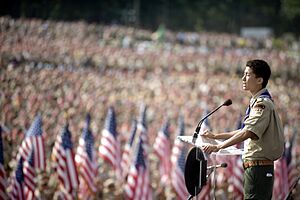
The National Scout Jamboree is a large gathering of Scouts and Venturers from all over the U.S. It usually happens every four years. The first jamboree was in 1937 in Washington, D.C. Over 27,000 Scouts and leaders attended. Since 2013, the jamboree has been held at The Summit Bechtel Family National Scout Reserve in West Virginia, which is a permanent site owned by Scouting America.
High Adventure Programs
Scouting America runs several national high-adventure bases. These places offer many programs and training. Typical activities include sailing, wilderness canoeing, or backpacking and camping trips. These bases are managed by the High Adventure Division of the National Council.
The high-adventure bases are Philmont Scout Ranch, Northern Tier National High Adventure Bases, Sea Base, and The Summit Bechtel Family National Scout Reserve.
Training for Leaders and Youth
Scouting America offers many training programs. These teach about youth protection, outdoor skills, and leadership.
Adult Leader Training
All adult leaders must complete Youth Protection Training. Training specific to their role is also required. After finishing basic training, a leader can wear a "Trained" emblem on their uniform.
Extra training is available for volunteers to learn outdoor skills. These include camping, hiking, first aid, Leave No Trace, swim safety, and more.
The highest level of adult training is Wood Badge. This program helps leaders develop their skills during a five-day outdoor experience.
Youth Leadership Training
Young Scout leaders can attend "Introduction to Leadership Skills for Troops" at their unit. Local councils offer "National Youth Leadership Training" (NYLT). The National Council offers "National Advanced Youth Leadership Experience" (NAYLE) at Philmont. Scouting America also has the NYLT Leadership Academy to train youth staff for council-level NYLT courses.
Venturers and Sea Scouts can attend "Introduction to Leadership Skills for Crews" or "Introduction to Leadership Skills for Ships." Crew officers can also go to "Crew Officer Orientation" and a council-provided "Kodiak" leadership program.
Members of the Order of the Arrow can attend the "National Leadership Seminar."
National Camping School
Scouting America runs a National Camping School program. This trains people to manage different parts of summer camps. Some training is online, but most areas require a week-long in-person program. After completing it, a person can wear the National Camping School patch. This certification is good for five years.
COPE Program
COPE stands for Challenging Outdoor Personal Experience. This program has a series of activities that test strength, agility, coordination, and problem-solving skills. These challenges are done alone and in groups.
Outdoor Program Values
Scouts see nature as an exciting place. The goal is for their youth experiences to make them love nature as they grow older. Scouts view nature as a precious gift. As Lord Baden-Powell said in 1919, "On breaking up camp leave two things behind you: 1. Nothing. 2. Your thanks."
How Scouting America is Organized
National Council
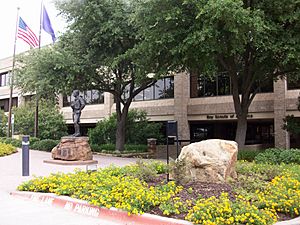
The National Council is the main governing body of Scouting America. It includes volunteer leaders who meet every year. The daily work of the National Council is handled by the Chief Scout Executive and other national staff. The national headquarters has been in Irving, Texas since 1979.
Since Scouting America started in 1910, the President of the United States has served as the organization's honorary chair during their time in office. Former presidents become honorary vice chairs for life.
National Executive Board
The Scouting America National Executive Board leads the organization. In 2015, it had 79 members. The board is led by the national president, a volunteer chosen by the National Council. The Chief Scout Executive is the board secretary. The board has committees that match the different departments of the National Council.
Important people who have been on the National Executive Board include Utah Senator Mitt Romney and AT&T CEO Randall Stephenson.
National Service Territories
For easier management, Scouting America is divided into sixteen National Service Territories (NSTs). These include areas for Scouts whose parents serve outside the U.S. Each NST covers several states or parts of states. Before 2021, Scouting America was divided into four regions: Central, Southern, Western, and Northeast.
Local Councils

The Scouting America program is managed through about 250 local councils. Each council covers an area that might be a city or a whole state. Councils get a yearly permission from the National Council and are usually set up as charity groups.
The way a local council is organized is similar to the National Council. The council executive board is led by the council president. It is made up of local community leaders chosen each year. The board plans the council's programs and carries out its policies. Board members are volunteers.
A Scout executive manages the council's daily work. This includes money, property, awards, registrations, and Scout Shop sales. They work with other paid staff. Volunteer commissioners help units and make sure Scouting standards are met.
Scouting America also has two councils overseas. These mostly serve military and diplomatic families in Europe and Asia. The Transatlantic Council is in Italy and serves units in Europe and Africa. The Far East Council is in Japan and serves units across Asia. The Aloha Council in Hawaii also serves units in American Samoa, Guam, the Northern Mariana Islands, and other countries.
The Greater New York Councils are special because they are divided into five boroughs. Each borough has its own Scout executive and is then divided into districts. Districts are responsible for running Scout units. They are mostly run by volunteers.
Local Groups and Units
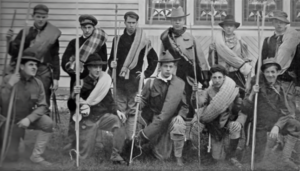
Scouting America works with community groups like churches, clubs, and other associations. These groups offer the Scouting program in their local areas. These groups are called "chartered organizations." Each chartered organization provides a meeting place for the Scouts. They also oversee the volunteer leaders and agree to follow Scouting America's safety rules and values-based programs.
Within each chartered organization, there can be one or more "units." A unit is a group of young people and adults, like a Cub Scout pack, Scouts BSA troop, Venturing crew, or Sea Scout ship. Scouting America councils provide leader training, activities, camping programs, and support. Units also create their own activities, like monthly camping trips or service projects. Most units meet weekly at the chartered organization's location.
The Church of Jesus Christ of Latter-day Saints was the first partner to support Scouting in the United States. It adopted the program in 1913. It was the largest single sponsor of Scouting until it stopped sponsoring units at the end of 2019.
Leadership in Scouting
In all Scouting units for older youth (like Scouts BSA, Venturing, and Sea Scouts), both adult leaders and youth leaders guide the unit. This is a very important part of the program. To learn leadership, young people must actually serve in leadership roles. Adult leaders can be men or women in all positions.
A well-run Scouts BSA troop is led by the Senior Patrol Leader, who is chosen by the troop. This youth leader and other youth leaders are advised by adult leaders. Scouts are expected to lead themselves.
Funding Scouting America
The National Council is a non-profit organization. It gets money from private donations, membership fees, company sponsors, and special events. In 2015, its total income was $237 million.
Many large companies also donate to Scouting America. In 2010, some of the top company donors included Intel, Emerson, Verizon, and 3M.
Scouting's Impact on American Life

Scouting and Boy Scouts are well known in American culture. About 130 million Americans have been part of Scouting America programs at some point. The term "Boy Scout" is often used to describe someone who is honest and helpful.
Many famous Americans were Scouts when they were young. These include filmmaker Steven Spielberg and adventurer Steve Fossett. Many U.S. presidents were also Scouts. Over two-thirds of all astronauts have been involved in Scouting. Eleven of the twelve men who walked on the Moon were Scouts, including Eagle Scouts Neil Armstrong and Charlie Duke. The pinewood derby, a wood car racing event for Cub Scouts, is a very popular event.
President Gerald Ford once said that because of Scouting principles, he was a better athlete, naval officer, congressman, and president.
Famous American artist Norman Rockwell created many illustrations for the Boy Scouts of America for much of the 20th century. Starting in 1913, Rockwell drew covers for Boys' Life magazine. He also created the organization's annual calendar illustrations between 1925 and 1976.
In 1969, for Rockwell's 75th birthday, he posed for a calendar illustration called Beyond the Easel. In 1976, Rockwell's Scouting paintings toured the nation and were seen by many people.
Alvin Townley wrote in his book Legacy of Honor about the positive impact of Eagle Scouts in America. He noted that Eagle Scouts are often found in important roles, like in the United States Senate. Former Governor Rick Perry of Texas, an Eagle Scout, wrote a book defending Scouting's values.
Mark Mays, CEO of Clear Channel Communications, said in 2008 that Scouting has a huge positive impact on young people. He noted that it helps them focus on core values like being trustworthy, loyal, and helpful.
New York City Mayor Michael Bloomberg said that the Scout Law – a Scout is trustworthy, loyal, helpful, friendly, courteous, kind, obedient, cheerful, thrifty, brave, clean, and reverent – includes "all the American values." He believes it is one of the country's great strengths.
Peter Applebome, an editor for The New York Times, wrote in 2003 about his experience in Scouting with his son. He felt lucky to share his son's youth through Scouting. He concluded that Scouting's core values are wonderful building blocks for life. He also said that Scouting is one of the few activities where kids genuinely cooperate, not just compete.
In the early 1900s, Halloween had become a night of vandalism. Around 1912, the BSA and other groups worked to encourage a safe celebration.
Scouting America is careful about how its uniforms and badges are used in movies and TV shows. Because of this, most films in the U.S. use made-up Scouting groups. Examples include the "Order of the Straight Arrow" in King of the Hill and the "Indian Guides" in the 1995 film Man of the House. However, Disney's Follow Me, Boys! (1966) and the end of The Sopranos show real Cub Scouts.
Doing Good Turns
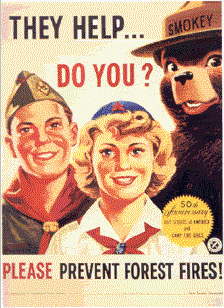
Since Scouting began, Scouts have been encouraged to "Do a Good Turn Daily." This is the slogan for Scouting America. The first national Good Turn was promoting a safe Fourth of July in 1912. During World War I, the slogan "Every Scout to Save a Soldier" encouraged children to help sell war savings stamps. Scouting for Food is an annual program started in 1986 that collects food for local food banks.
In 1997, the BSA started "Service to America." The goal was for youth members to provide 200 million hours of service by the end of 2000. As part of this, the BSA worked with the National Park Service. In 2003, the Department of the Interior expanded this with "Take Pride in America." "Service to America" became "Good Turn for America" in 2004. It expanded to help with hunger, homelessness, and health issues, working with groups like the Salvation Army and the American Red Cross.
Special Celebrations
115th Anniversary Celebrations
During the weekend of February 8, 2025, which was the organization's 115th anniversary, many famous places across the U.S. were lit up in red, white, and blue. These included Niagara Falls, the Empire State Building, and the Pennsylvania State Capitol.
See also
 In Spanish: Boy Scouts de América para niños
In Spanish: Boy Scouts de América para niños


